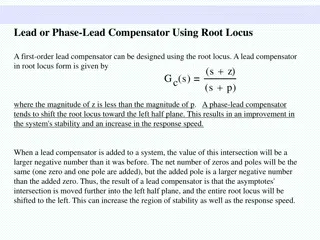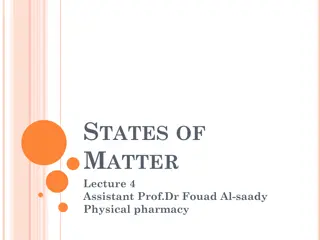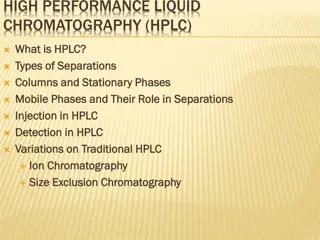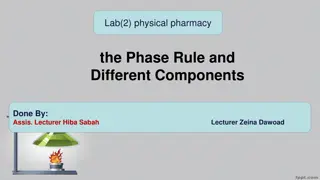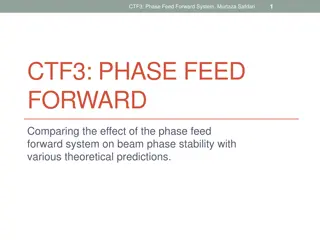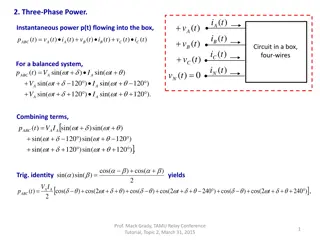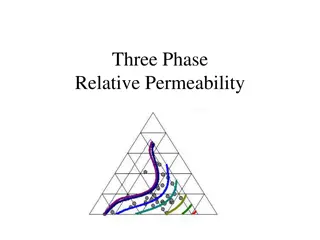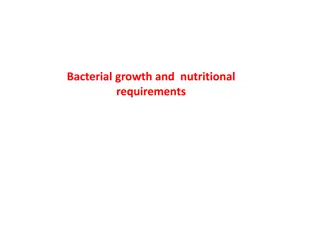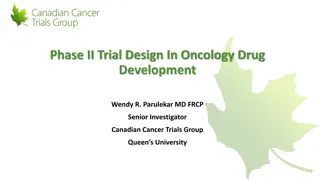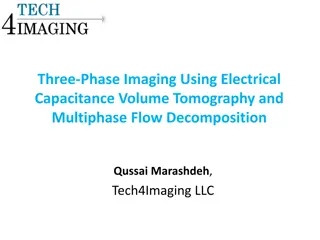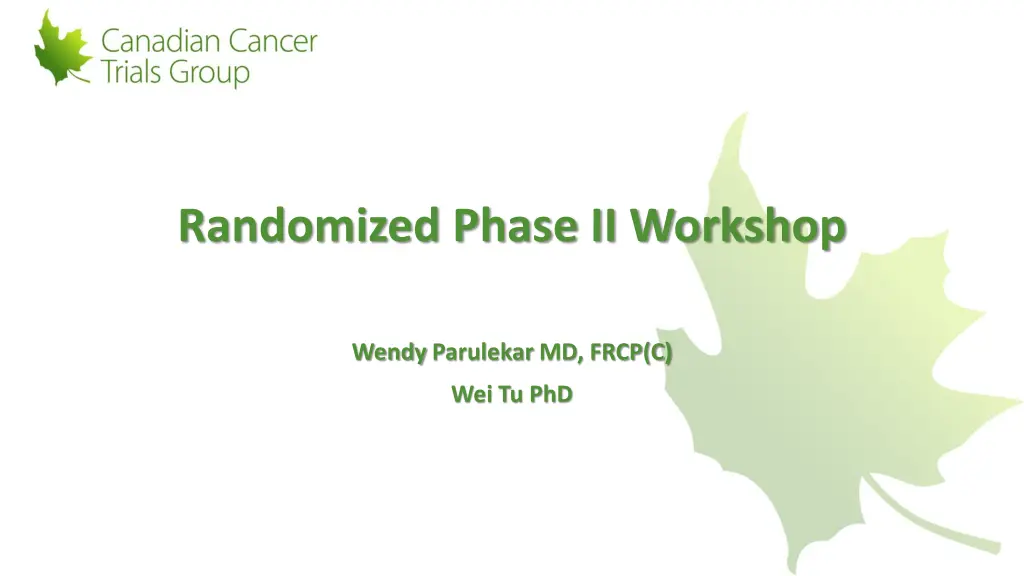
Randomized Phase II Workshop: Design Review and Trial Proposals
Delve into the classification and critique of randomized phase II trial designs, focusing on a concept in head and neck cancer. Explore the ongoing CCTG HN 9 study and its utilized trial design. Understand the defining characteristics, statistical frameworks, and classification of randomized phase II designs. Furthermore, propose a randomized phase II trial design for intermediate-risk HPV-related oropharyngeal carcinoma, evaluating novel therapeutics and statistical frameworks against the standard of care.
Download Presentation

Please find below an Image/Link to download the presentation.
The content on the website is provided AS IS for your information and personal use only. It may not be sold, licensed, or shared on other websites without obtaining consent from the author. If you encounter any issues during the download, it is possible that the publisher has removed the file from their server.
You are allowed to download the files provided on this website for personal or commercial use, subject to the condition that they are used lawfully. All files are the property of their respective owners.
The content on the website is provided AS IS for your information and personal use only. It may not be sold, licensed, or shared on other websites without obtaining consent from the author.
E N D
Presentation Transcript
Randomized Phase II Workshop Wendy Parulekar MD, FRCP(C) Wei Tu PhD
Objectives To review the classification of randomized phase II trial designs To propose and critique potential randomized phase II trials designs for a concept in head and neck cancer (case scenario to be presented) To classify and describe the randomized phase II trial design utilized in the ongoing CCTG HN.9 study (NCT03410615) 2
Defining Characteristics Objective(s) estimate activity w/wo benchmarking against a concurrent control select the most promising novel therapy(ies) based on activity estimate activity of a novel therapy in the initial phase of a phase III RCT Endpoints Measure of activity informed by mechanism of action of novel therapy e.g. objective response rate (ORR); lack of progression Statistical Framework H0, HA, (Type 1 error), (Type II error); comparative measures eg. hazard ratio (hazard ratio) 3
Classification of Randomized Phase II Designs Experimental Arm with Concurrent Control Multiple Experimental Arms (Selection Design) Direct Comparison of Experimental to a Standard Arm (Screening Design) Randomized Phase II/III 4
Intermediate Risk HPV Related Oropharyngeal Carcinoma Standard of care: chemoradiotherapy: 70Gy/35fr + platinum Event free survival* 83% at 3 years high burden of treatment related morbidity Can we harness the immune system to improve outcomes and replace cisplatin using immune checkpoint inhibitors? 5
Propose a Randomized Phase II Trial Design Patient population: Intermediate risk, HPV+ oropharyngeal carcinoma Goal: Evaluate novel therapeutics durvalumab (anti PDL1 antibody) +/- tremelimumab (anti CTLA4 antibody) Statistical framework: Standard of care: RT + platinum EFS 83% at 3 years Target EFS: 91% at 3 years Type 1 error: 0.1 (one sided) Type II error: 0.2 6
CCTG HN.9 (NCT03410615) Randomized Phase II Study of Cisplatin plus Radiotherapy versus Durvalumab plus Radiotherapy followed by Adjuvant Durvalumab versus Durvalumab plus Radiotherapy followed by Adjuvant Tremelimumab and Durvalumab in Intermediate Risk HPV-Positive Locoregionally Advanced Oropharyngeal Squamous Cell Cancer (LA-OSCC) Study Chairs: Anna Spreafico Khalil Sultanem Senior Investigator (SI): Wendy Parulekar Senior Biostatistician: Bingshu Chen Study Coordinator (SC): Kate Whelan Supported by: AstraZeneca 7
HN.9 Study Design Arm A: Radiation/Cisplatin R A N D O M I Z E LA-Oropharyngeal SCC p16 positive Intermediate Risk: T1-2 N2b (smokers) T3 N0-N2b (smokers) T1-3 N2c (any smoking hx) Arm B: Radiation/Durvalumab + Maintenance Durvalumab Non-comparative Randomized Arm C: Radiation/Durvalumab + Maintenance Durvalumab/Tremelimumab Phase II study N = 240 (1:1:1, 80 pts per arm) 8
Sample Size Considerations Design: randomized non-comparative Primary endpoint: EFS Sample size: 80 patients each arm (total = 240 patients) Null hypothesis (H0): to exclude a 3-year PFS of 83% or less Alternative hypothesis (H1): new treatment will improve 8% of 3-years PFS to 91%. One-side type I error of 0.1 If the treatment is effective, the power of rejecting the null hypothesis is greater than 80% Duration of study, 2.5 years of accrual and 2.5 years of follow-up Null hypothesis (H0) will be rejected if a total of 11 PFS events or less is observed with 267.3 person-year of follow-up at the final analysis, which is equivalent to observed a 3-year FFS rate of 88.4% or higher to ensure the lower bound of one-side 90% CI is greater than 83% 9
Statistical Design This is a randomized non-comparative trial with 3-year EFS rate as the primary endpoint. A sample size of approximately 240 patients total (i.e. 80 patients per group) is anticipated, accounting for a 2.5% lost to follow-up patients. The duration of study will be 5.5 years with 2.5 years of accrual and 3 years of follow-up for each of Arm A, Arm B and Arm C. Update as per Amendment #1: This is a randomized non-comparative trial with 3-year EFS rate as the primary endpoint. A sample size of approximately 180 patients total (i.e. 60 patients in Arm A and 120 patients in Arm B is anticipated), accounting for a 2.5% lost to follow-up patients. Enrollment of 60 patients and 120 patients to Arms A and B respectively would enable the ability to reject the null hypothesis of 3 year EFS 83% or lower with 90% power and one-sided alpha of 0.10 when the expected 3-year EFS in Arm B is 91% or higher. 11
Classification of Randomized Phase II Designs Experimental Arm with Concurrent Control Multiple Experimental Arms (Selection Design) Direct Comparison of Experimental to a Standard Arm (Screening Design) Randomized Phase II/III 12
Objectives To review the classification of randomized phase II trial designs To propose and critique potential randomized phase II trials designs for a concept in head and neck cancer (case scenario to be presented) To classify and describe the randomized phase II trial design utilized in the ongoing CCTG HN.9 study (NCT03410615) 13


